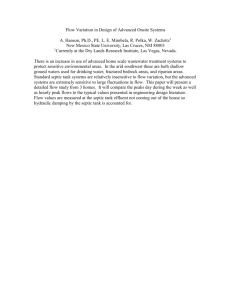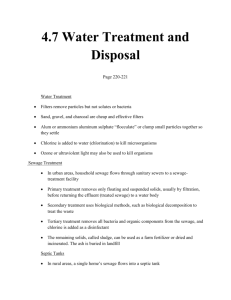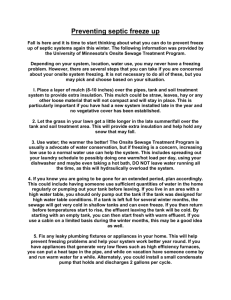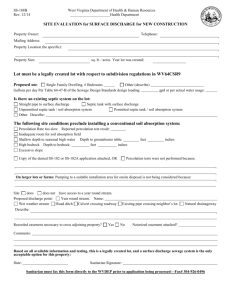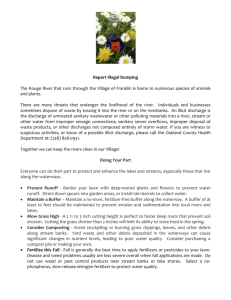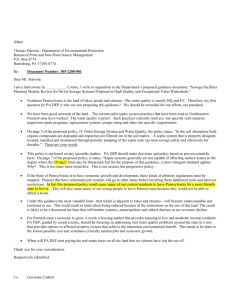Septic System Operation and Maintenance
advertisement
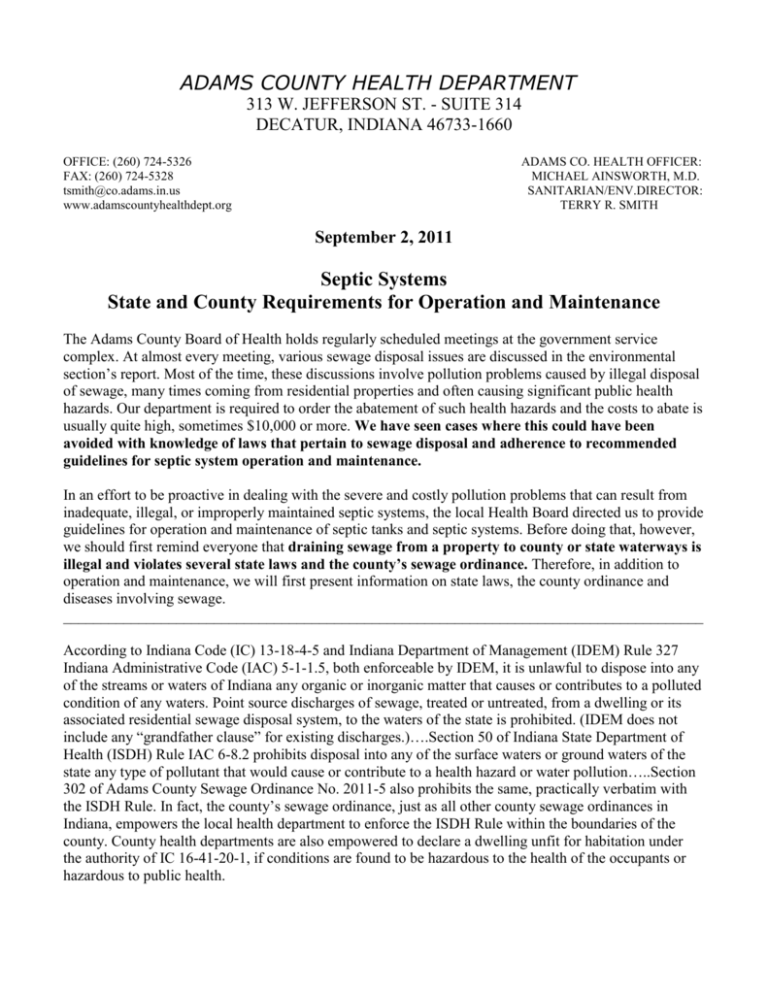
ADAMS COUNTY HEALTH DEPARTMENT 313 W. JEFFERSON ST. - SUITE 314 DECATUR, INDIANA 46733-1660 OFFICE: (260) 724-5326 FAX: (260) 724-5328 tsmith@co.adams.in.us www.adamscountyhealthdept.org ADAMS CO. HEALTH OFFICER: MICHAEL AINSWORTH, M.D. SANITARIAN/ENV.DIRECTOR: TERRY R. SMITH September 2, 2011 Septic Systems State and County Requirements for Operation and Maintenance The Adams County Board of Health holds regularly scheduled meetings at the government service complex. At almost every meeting, various sewage disposal issues are discussed in the environmental section’s report. Most of the time, these discussions involve pollution problems caused by illegal disposal of sewage, many times coming from residential properties and often causing significant public health hazards. Our department is required to order the abatement of such health hazards and the costs to abate is usually quite high, sometimes $10,000 or more. We have seen cases where this could have been avoided with knowledge of laws that pertain to sewage disposal and adherence to recommended guidelines for septic system operation and maintenance. In an effort to be proactive in dealing with the severe and costly pollution problems that can result from inadequate, illegal, or improperly maintained septic systems, the local Health Board directed us to provide guidelines for operation and maintenance of septic tanks and septic systems. Before doing that, however, we should first remind everyone that draining sewage from a property to county or state waterways is illegal and violates several state laws and the county’s sewage ordinance. Therefore, in addition to operation and maintenance, we will first present information on state laws, the county ordinance and diseases involving sewage. _____________________________________________________________________________________ According to Indiana Code (IC) 13-18-4-5 and Indiana Department of Management (IDEM) Rule 327 Indiana Administrative Code (IAC) 5-1-1.5, both enforceable by IDEM, it is unlawful to dispose into any of the streams or waters of Indiana any organic or inorganic matter that causes or contributes to a polluted condition of any waters. Point source discharges of sewage, treated or untreated, from a dwelling or its associated residential sewage disposal system, to the waters of the state is prohibited. (IDEM does not include any “grandfather clause” for existing discharges.)….Section 50 of Indiana State Department of Health (ISDH) Rule IAC 6-8.2 prohibits disposal into any of the surface waters or ground waters of the state any type of pollutant that would cause or contribute to a health hazard or water pollution…..Section 302 of Adams County Sewage Ordinance No. 2011-5 also prohibits the same, practically verbatim with the ISDH Rule. In fact, the county’s sewage ordinance, just as all other county sewage ordinances in Indiana, empowers the local health department to enforce the ISDH Rule within the boundaries of the county. County health departments are also empowered to declare a dwelling unfit for habitation under the authority of IC 16-41-20-1, if conditions are found to be hazardous to the health of the occupants or hazardous to public health. According to the ISDH, there are many diseases caused by sewage or sewage-contaminated water. On its website (www.in.gov/isdh/), the ISDH provides descriptions of many of the diseases associated with sewage. Several of the more common diseases are Campylobacter enteritis, Crytosporidiosis, E. coli Diarrhea, several types of Encephalitis (including West Nile Virus), Gastroenteritis, Giardia, Hepatitis A, Salmonellosis and Shigellosis. We advise rural residents of Adams County that it is very important to prevent the potential for the transmission of sewage-related diseases by maintaining septic systems. A septic “system” is an individual wastewater treatment system that uses soil, sometimes in combination with sand, to treat and absorb wastewater. Septic “systems” have two main parts, a septic tank and an absorption area. Sometimes a third step can be added between the septic tank and the absorption area for further treatment. Sewage from the home enters into the septic tank where the heavier solids settle out and the scum rises to the surface. (That is considered “primary treatment”.) The water between the scum and solid layer enters into the absorption area where it trickles down into the soil. If an individual does not have an absorption area and only a tank, it is NOT a “septic system”, but it is still very important to maintain the tank so that there is at least a minimum of primary treatment provided before the sewage illegally enters the environment. “Maintenance” for a septic tank consists of having it pumped clean on a regular basis by a licensed professional. Generally, a septic tank should be inspected by a licensed professional every 2-3 years, depending on the number of people in a house. Purdue University uses a figure of 100 gallons of tank capacity per person per year. (For example, a family of five with a 1000-gallon septic tank should have the tank pumped every two years.)…. Garbage disposals are NOT recommended for use with a septic system because they add twice as many solids and will require much more frequent pump-outs by a licensed professional and can even endanger the performance of the septic system….Regardless of the claims of septic tank additive companies (and we have seen a system fail as a result of using an additive), THERE IS NO SUBSTITUTE FOR HAVING THE TANK PUMPED OUT ON A REGULAR BASIS. Some other recommendations for homeowners include the following: -have the professional cleaner inspect the interior of the tank, especially the baffles -extend risers to the surface on all tanks and system components to allow easier, more frequent and, perhaps, less costly cleanouts (if the cleaner does not have to dig down to the tank) -have the professional cleaner install an effluent filter on the outlet end of the tank, which filters solids and inhibits carryover to the absorption area or field tile -two compartment tanks, or two single compartment tanks, are required in our county for new tanks, or tank replacements, and when a tank is replaced, the system must be upgraded with an absorption area if there was previously only a tank -do not put anything down the toilet or drains that will not break down easily, such as oil, grease, coffee, paper towels, cigarette butts, pharmaceuticals, feminine products, diapers, household cleaners, bleach, cat litter, fertilizers, pesticides, paints or thinner -minimize excess water use and do not connect any clean water sources, such as sump pumps or jacuzzis, to the septic system -divert run-off water from your lawn, roof, and basement drain away from the absorption area. If individuals have questions, or would like to discuss anything related to septic tanks, septic systems, components, requirements, or even to report a suspected violation, feel free to contact this department at the above address or e-mail. We have an informative 27-page “Septic Systems Booklet” available at our office and on our website and there will be more information posted on the website as it becomes available. Terry R. Smith, Sanitarian/Env Director
